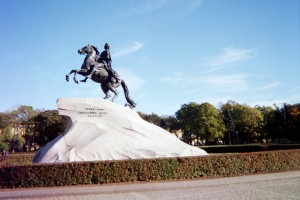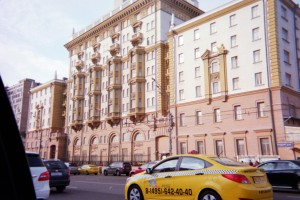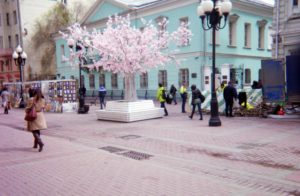Popular billboard of Putin in Crimea that reads: Crimea.Russia.Forever
Putin held telephone talks with numerous leaders in the Middle East last Tuesday, including Egypt, Saudi Arabia and Israel.
According to the Kremlin press service report of the talks between Putin and Israeli PM Netanyahu, topics discussed included the sharing of mutually beneficial security information and progress in the fight against terrorism in Syria. Due to the wording, I’d say that there was no new agreement reached on the situation in Syria, in which Israel has given assistance to jihadist rebels in the past. Israel does not see the maintenance of the Assad government as in its interest. The current right-wing Israeli government wants to see any governments that support the Palestinian cause cast aside in order to pursue a program of forcing the Palestinians to accept whatever terms the Israelis want to offer for “peace” – which means Israel not allowing any viable Palestinian state or independence.
Next, Putin had a conversation with Egyptian president Abdel Fattah Sisi. The two leaders discussed the final phase of routing terrorists from Syria and a joint nuclear energy project. From the Kremlin press service:
“Vladimir Putin informed the Egyptian leader in detail about the Russian assessments of the latest developments in the situation in Syria in the context of the final stages of the military operation to destroy terrorists in that country and discussed the results of the recent talks with Syrian President Bashar Assad,” press service of the Russian president said.
Moreover, Russian President and Egyptian Leader have discussed in phone talks on Tuesday major joint projects, including in the nuclear energy sector, press service said.
“The topical issues of the bilateral agenda were touched upon, with focus on the implementation of major joint projects, including in the nuclear energy sector. The sides reaffirmed mutual satisfaction with the overall development of friendly Russian-Egyptian relations,” the statement said.
Putin then got on the horn with the Saudi king. Syria, again, was a major topic of conversation.
“The leaders continued the exchange of views on the situation in the Middle East region and discussed issues related to the prospects for a long-term settlement of the Syrian conflict in light of recent successes in the fight against terrorist groups there,” the press service said in a statement.
According to the statement, the Russian president noted that the Syrian National Dialogue Congress, to be held in Sochi, will give impetus to the intra-Syrian contacts and to the settlement of the Syrian conflict in general, as well as stimulate work under the UN aegis in Geneva.
The Kremlin press service also said in a statment that Putin has informed all of his counterparts about the Monday meeting with Syrian President Bashar Assad, as well as about the main issues on the agenda of the upcoming summit of the countries-guarantors of the Astana process — Russia, Iran and Turkey — in Sochi on November 22.
On the following day, Putin had a 1-hour phone conversation with President Trump in which Syria and Ukraine apparently comprised the majority of the discussion. ZeroHedge reported the following:
According to ABC, president Donald Trump spoke for more than an hour Tuesday by phone with Russian President Vladimir Putin. Syria, Iran, North Korea and Ukraine were on the agenda, the White House said.
The Kremlin echoed the White House, and said that the two leaders discussed “a number of topics”, including the Syrian crisis, the North Korean nuclear problem and the situation in Afghanistan as well as the Ukrainian crisis. Putin briefed Trump in the phone call about his talks with the Syrian leader and plans for a political settlement in Syria.
Putin stressed that there were no alternatives for full implementation of the Minsk agreements on peaceful settlement of the armed conflict in eastern Ukraine.
“Considering the crisis situation in southeastern Ukraine, the Russian president pointed out the absence of a real alternative for the unconditional implementation of the Minsk accords signed on February 12, 2015,” the statement said.
Speaking of Ukraine, as winter approaches the UN and other aid organizations are highlighting the plight still experienced by many in the Donbass, due to the “frozen” conflict there. Euronews provided the following details:
Various aid organizations and volunteers help the population affected by the protracted conflict. Food, medicine, clothes are often collected and delivered here by Ukrainians from every corner of the country.
There are still inaccessible areas. In the cold winter months the need for aid only increases.
A Christian mission from Dnipropetrovs’k oblast’ brings bread and spiritual literature to Krasnogorovka, located around 1 km from the frontline. Aid is aimed at the most vulnerable sections of the population. Euronews previously reported the example of a social bakery project, based in Marinka, where the situation remains tense. Locals are regularly subjected to the sound of explosions and gunfire and forced to hide in underground cellars for safety.
Marina, a resident of the village of Kamyanka, in the Volnovakha district in Donetsk oblast’, said she was afraid to return home the day she spoke to Euronews as she could hear heavy explosions in the fields nearby. Earlier, when her village was shelled, she had lost her hearing, only partially recovering since. A house in neighbouring Hranitne was damaged at the end of September.
Freedom of movement in the region continues to be restricted. The waiting time at roadblocks installed by the Ukrainian army and the separatists stretches to many hours, causing enormous human suffering as the roadblocks lack even basic facilities. Searches, interrogations, long lists of banned products provoke frustration and anger among the local population. With the winter season approaching, the roadblocks’ working hours have been shortened by both sides furthermore.
“Thousands of people are without electricity, gas and water, as the ongoing conflict continues to take a heavy toll on critical civilian infrastructure crisscrossing the contact line”, says Ertugrul Apakan, the Chief Monitor from OSCE, whose Special Monitoring Mission has worked in Ukraine since 2014.
In the midst of this, Igor Plotnitsky, the leader of the Lugansk People’s Republic (LPR) for the past couple of years, has apparently been forced to resign and temporarily fled to Russia as former minister of state security Leonid Pasechnik has now taken over the leadership of the republic. Russia expert Paul Robinson reported the following on his blog:
Plotnitsky, meanwhile, has been appointed the LPR’s representative in negotiations over implementation of the Minsk Agreements, which he signed, and which are meant to provide a blueprint for an eventual peace settlement in Ukraine. What does this all mean?
The Russian online newspaper Vzgliad has a few ideas. According to an article by Pyotr Akopov, stories of treason in high places are false, and the LPR is secure. Akopov adds that, ‘merger with the DPR [Donetsk People’s Republic] is currently impossible’ and could happen only in the event of a renewal of large-scale military operations. Plotnitsky’s involvement with the Minsk negotiations doesn’t mean very much, as the negotiations are not going anywhere. And finally, recent events won’t change the relationship between the Russian Federation and the LPR. In short, after a brief flurry of excitement, everything will return to the way it was a week ago. It was all much ado about nothing.
Akopov comments also that the events in the LPR show that ‘Russia supports and helps the republics [LPR and DPR] in all sorts of ways, but in no way leads them.’ To make his point, Akopov quotes a response Vladimir Putin gave to a questioner who suggested that Moscow is in total charge of the rebel Ukrainian republics: ‘You’ve got it wrong … these guys are really stubborn … they’re difficult.’ The Vzgliad article concludes that ‘If Moscow was in charge of Lugansk, it wouldn’t have let the conflict among the republic’s leaders develop into open confrontation.’ Having said as much myself in a recent post, I concur.
Robinson provides more context and discussion on the complicated client-patron relationship between Russia and the Donbass here.
**************************************************************************
Upon discovery that he was named on an “enemy chart” during a recent NATO drill in mid-November, Turkish president Erdogan pulled Turkish troops out of the exercise in Norway. According to ZeroHedge:
The president said he was informed about the issue by Chief of General Staff Gen. Hulusi Akar and EU Affairs Minister Omer Celik.
“They told me that they are withdrawing our 40 soldiers from there [Norway],” Erdogan said.
“I told them to do that immediately. There can be no alliance like that.”
While the NATO powers increasingly tick off the Turkish leadership, Russia has been deftly filling the void with a pending sale of the S400 anti-missile shield, cooperation on Turkstream, etc. According to Al-Monitor‘s sources, Russia’s wooing is paying off:
Nihat Ali Ozcan, a consultant with the Economic Policy Research Foundation of Turkey, believes Russia is indeed laying the groundwork to recast the Turkish public’s perception of the United States, the European Union and NATO. “No wonder we are overwhelmed with Russian-origin news, some factual and some manufactured according to the need of the day,” he told Al-Monitor.
“Putin’s team is competent — not a bunch of pompous imbeciles — and under the management of a former intelligence man and [with] a wisely designed strategy,” he added. Ozcan, an academic and retired major with the Turkish armed forces, underlines that the West’s contradictory policies and populist narratives against Turkey are also driving the Turkish public toward Russia.
My personal opinions match those of Ozcan and are backed by the results of a poll, “Turkey’s Foreign Policy: Research on Public Perceptions,” released by Kadir Has University in July. The poll showed “combating terror” was seen by 44.2% of respondents as the biggest problem for Turkish foreign policy. The Syrian war was second, with 24.6%.
Moscow, which is aware of these two sensitivities, skillfully paints the United States as the leading threat in terror and on Syria issues, while managing to keep a low profile in the media regarding its own relations with the Kurdistan Workers Party and its supposed Syrian offshoot, the Democratic Union Party — both of which Turkey considers terrorist groups. In this annual poll, one striking finding was that the percentage of the Turkish public that perceives Russia as a threat dropped from 34.9% in 2016 to 18.5% in 2017.
**************************************************************************
The air force is now on track to triple the number of bombs being dropped in Afghanistan – the nation that officially began Washington’s War on Terror after 9/11/01. As the longest U.S. war on record – and Afghanistan being no closer to a Taliban-free, terrorist-free oasis of liberal democracy, heroin-free flourishing economy and women’s rights – it will likely just represent flushing more money down the toilet that already has sucked up ~$8 trillion. Democracy Now! reports:
This comes as a new report from Brown University’s Costs of War Project estimates that the U.S. wars since the 9/11 attacks in 2001 will cost up to $8 trillion in interest payments alone over the coming decades. Their report says the U.S. has already spent $4.3 trillion on the wars—and that the U.S. will be paying trillions of dollars in interest on the war debt for decades to come.
To get some perspective on just how much money we’re talking about here, go here to get an idea of what $1 trillion looks like.
**************************************************************************
To conclude this week’s post, I wanted to share an excerpt from a thought-provoking article from Canadian Russia expert Patrick Armstrong entitled NATO: A Dangerous Paper Tiger. Considering the fact that NATO can’t even beat some goat herders in flip-flops in Afghanistan, the points made in this article sound plausible to me.
Some Russians are concerned that there are today more hostile troops at the Russian border than at any time since 1941. While this is true, it is not, at the moment, very significant. The Germans invaded the USSR with nearly 150 divisions in 1941. Which, as it turned out, were not enough.Today NATO has – or claims to have – a battle group in each of the three Baltic countries and one in Poland: pompously titled Enhanced Forward Presence. The USA has a brigade and talks of another. A certain amount of heavy weaponry has been moved to Europe. These constitute the bulk of the land forces at the border. They amount to, at the most optimistic assessment, assuming everything is there and ready to go, one division. Or, actually, one division equivalent (a very different thing) from 16 (!) countries with different languages, military practices and equipment sets and their soldiers ever rotating through. And, in a war, the three in the Baltics would be bypassed and become either a new Dunkirk or a new Cannae. All for the purpose, we are solemnly told, of sending “a clear message that an attack on one Ally would be met by troops from across the Alliance“. But who’s the “message” for? Moscow already has a copy of the NATO treaty and knows what Article V says.
In addition to the EFP are the national forces. But they are in a low state: “depleted armies” they’ve been called: under equipped and under manned; seldom exercised. The German parliamentary ombudsman charged with overseeing the Bundeswehr says “There are too many things missing“. In 2008 the French Army was described as “falling apart“. The British Army “can’t find enough soldiers“. The Italian army is ageing. Poland, one of the cheerleaders for the “Russian threat” meme, finds its army riven over accusations of politicisation. On paper, these five armies claim to have thirteen divisions and thirteen independent brigades. Call it, optimistically, a dozen divisions in all. The US Army (which has its own recruiting difficulties) adds another eleven or so to the list (although much of it is overseas entangled in the metastasising “war on terror”). Let’s pretend all the other NATO countries can bring another five divisions to the fight.
So, altogether, bringing everything home from the wars NATO is fighting around the world, under the most optimistic assumptions, assuming that everything is there and working (fewer than half of France’s tanks were operational, German painted broomsticks, British recruiting shortfalls), crossing your fingers and hoping, NATO could possibly cobble together two and a half dozen divisions: or one-fifth of the number Germany thought it would need. But, in truth, that number is fantasy: undermanned, under equipped, seldom exercised, no logistics tail, no munitions production backup, no time for a long logistics build up. NATO’s armies aren’t capable of a major war against a first class enemy. And no better is the principal member: “only five of the US Army’s 15 armoured brigade combat teams are maintained at full readiness levels“. A paper tiger.









